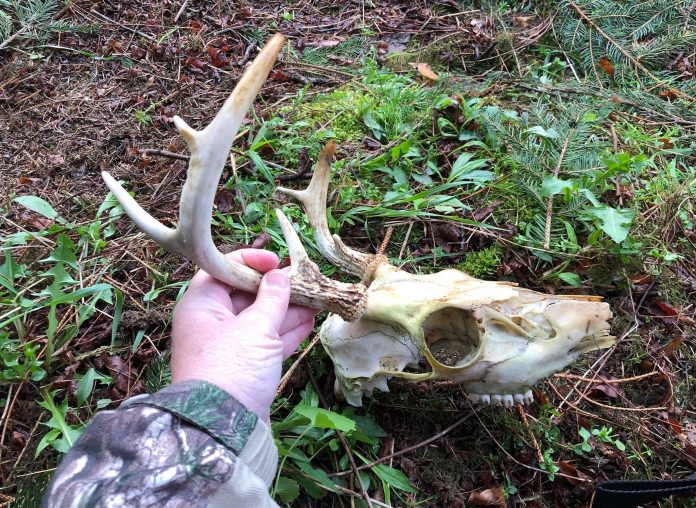
Shed Hunting. No, not garden sheds – deer antlers that have been shed.
When I first heard about this activity, I was like… what?
I had honestly never thought about the fate of last season’s deer antlers before. But combing the woods in search of deer antlers dropped when the rut is over is an actual thing. It is called shed hunting and I was intrigued. I set about educating myself. What follows is some of what I learned.
What is Shed Hunting?
The short answer to the question “What is shed hunting”, is that this is the practice of walking through woodland and field areas frequented by deer with the express purpose of trying to find antlers that have fallen off the heads of bucks who survived the most recently completed hunting season.
The “why” is a little more complicated. Let’s start with a short biology lesson on antlers. So what are antlers anyway?
Antler Biology
Antlers are actually bone (they aren’t “horns”, which are biochemically different and more akin to fingernails). Like skeletal bone, antlers are made up of calcium and phosphorus. Except unlike skeletal bone, antlers are grown and shed annually in male deer-type species in response to testosterone levels, thyroid hormone, and other influences both biochemical and environmental (like the amount of daylight in the season).
Although influences such as genetics and age control the ultimate size of antlers, antler growth is also heavily dependent upon nutrition. So a well-fed buck with a nice rack is essentially advertising his health and vitality to female deer and male breeding rivals (and also to trophy hunters).
After the breeding season (the rut) is over, testosterone levels drop. In response to that signal, osteoclasts (cells which break down bone) act at the site where the antler connects to the pedicle on the skull. The bone connection is gradually broken down, connective tissue invades, the antler loosens, eventually falls off, and is left wherever it fell. One article said that deer behavioral study suggests that there may be some pain involved in the shedding process. I never thought about that before.
If the antler stays where it is on the ground, it will be eventually gnawed upon and eaten by rodents and other woodland creatures as a source of calcium and phosphorus. It doesn’t go to waste.
Why Shed Hunt?
For some people shed hunting is just an excuse for a late winter/early spring walk in the woods. For other people it can be considered part of the scouting and patterning process. Woods walking and shed hunting can help in the learning curve of understanding buck habits in the area you hunt. That can help to better predict future activity for subsequent hunting seasons.
In addition to the use of game cameras, shed hunting gives landowners a way to assess the health and rack production of their local herd in the off-season, since a buck would have to survive the hunting season in order to shed in the spring.
State Laws Vary
Check your state game law before you go, though. In some areas it is technically illegal to posses a part of a game animal that you didn’t kill yourself. (Stupid, I know). Some states require a permit or training class (yes, really). Some states say you cannot take antlers if they are still attached to a skull. This article outlines some of the state laws from 2018. Some of the weird ones are being addressed by state legislatures.
Where and When
Through my reading I’ve learned that prime spots for shed hunting include: Winter bedding and feeding areas, south-facing slopes, evergreens (which can provide the deer thermal cover and shelter from snow), water sources, and obstacles such as fences or streams (where jumping might cause a loose antler to fall off). Prime time to do this is late December through March or even April depending upon your geographic area.
Uses for Antlers
-Dog chews – Because antler bone is formed differently than skeletal bone, antlers apparently don’t splinter like skeletal bone and are thus safer for your dog to chew on.
-Home decor
-Buttons
-Jewelry
-Knife handles
Be aware however that antler cannot legally be sold in some states.
Deer antler – whether shed or on the hoof – is big business. Because of this, there is a huge and growing market for deer feeds and supplements so that hopeful landowners can grow trophy bucks.
I found this all very interesting, and may try looking for antlers on my next woods traipsing. Maybe I’ll get an idea of what’s out there that I didn’t catch on my game camera. And maybe I’ll have better luck hunting something that doesn’t run away!



